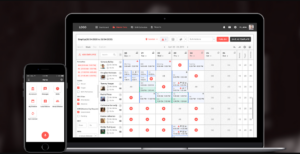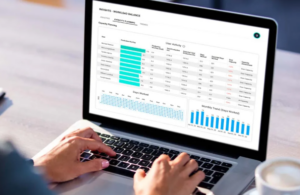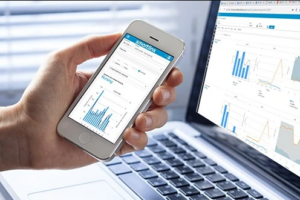Workforce Management Software for Enterprises – Managing a large workforce efficiently can be a daunting task, but with the right workforce management software, enterprises can streamline operations, improve productivity, and reduce costs.
In this article, we’ll explore the top workforce management software for enterprises that offer unique features tailored to your business needs. We’ll cover product comparisons, benefits, and how to buy the best solution for your company.
What is Workforce Management Software?

Workforce Management Software (WFM) is a digital solution that helps enterprises manage their workforce by automating key functions such as scheduling, time tracking, payroll, and performance management. It ensures that businesses deploy the right people with the right skills at the right time, optimizing labor efficiency while cutting operational costs.
Key Features of Workforce Management Software
- Automated Scheduling: Reduces manual errors and ensures optimal shift planning.
- Time & Attendance Tracking: Allows managers to monitor employee work hours with precision.
- Performance Analytics: Provides valuable insights into employee productivity.
- Compliance Management: Ensures adherence to labor laws and regulations.
- Payroll Integration: Automates salary calculations and payouts.
Benefits of Workforce Management Software for Enterprises
Enhanced Productivity
Workforce management software automates routine tasks such as scheduling, time tracking, and reporting. By reducing manual work, managers can focus on strategic initiatives, allowing employees to spend more time on value-adding activities. Features like automated scheduling ensure that employees are assigned to the right tasks at the right times, leading to a more efficient workforce.
Cost Reduction
By optimizing labor deployment, workforce management software can significantly lower operational costs. Accurate time tracking minimizes instances of overtime and ensures that staffing levels match demand. This not only cuts down on unnecessary labor expenses but also helps prevent overstaffing, which can strain budgets.
Improved Compliance
Compliance with labor laws and regulations is critical for avoiding legal penalties. Workforce management software includes features that help businesses stay compliant by tracking working hours, managing breaks, and calculating wages in accordance with local laws. Automated alerts and reporting capabilities further ensure that businesses adhere to compliance requirements, reducing the risk of costly fines.
Real-time Analytics and Reporting
Many workforce management solutions come equipped with powerful analytics tools that provide real-time insights into employee performance, attendance, and productivity levels. These analytics help management make informed decisions based on accurate data. For example, businesses can identify trends in absenteeism or productivity, allowing them to address issues proactively.
Employee Engagement and Satisfaction
Offering employees a transparent and efficient system for managing their schedules, time-off requests, and performance feedback can significantly enhance job satisfaction. Features like self-service portals empower employees to manage their schedules and view their performance metrics, fostering a sense of ownership and engagement.
Streamlined Communication
Effective communication is essential for any organization, and workforce management software facilitates streamlined communication between management and employees. Features such as instant messaging, alerts for schedule changes, and updates on company policies help ensure that everyone is on the same page. This reduces misunderstandings and fosters a collaborative work environment.
Scalability
As enterprises grow, their workforce management needs can become more complex. Many workforce management solutions are scalable, meaning they can accommodate increasing numbers of employees and changing business requirements. Whether your business is expanding rapidly or experiencing seasonal fluctuations, workforce management software can adapt accordingly.
Enhanced Forecasting and Planning
Advanced forecasting features enable enterprises to predict workforce needs based on historical data, upcoming projects, and business trends. This predictive capability allows companies to prepare for busy periods or allocate resources effectively, ensuring they are always staffed appropriately.
Integration with Other Systems
Workforce management software often integrates seamlessly with other enterprise applications, such as Human Resource Management Systems (HRMS), Customer Relationship Management (CRM) software, and payroll systems. This integration ensures that all relevant data is synchronized, providing a holistic view of the workforce and enhancing overall operational efficiency.
Improved Time Management
Time is one of the most valuable resources for any enterprise. Workforce management software provides tools for tracking time and attendance accurately, helping businesses manage hours worked, overtime, and paid time off effectively. This leads to better allocation of time and resources, ensuring that employees can focus on their primary responsibilities without unnecessary distractions.
Top 5 Workforce Management Software for Enterprises

Here are the top workforce management software solutions that are best suited for large enterprises. Each offers a unique set of features, pricing models, and use cases tailored to different industries.
1. Kronos Workforce Central
Kronos Workforce Central is an industry leader in workforce management, offering an all-in-one solution for timekeeping, scheduling, and payroll management.
- Price: Custom pricing based on company size
- Pros:
- Robust scheduling tools
- Advanced labor analytics
- Integrated with payroll systems
- Cons:
- Complex setup
- Requires extensive training
- Best for: Enterprises with complex labor needs
2. ADP Workforce Now
ADP Workforce Now is a comprehensive human capital management (HCM) solution that includes workforce management, payroll, and HR tools.
- Price: Starts at $99/month
- Pros:
- Easy integration with other ADP products
- Scalable for mid-sized to large enterprises
- Strong compliance tools
- Cons:
- Higher pricing for advanced features
- Limited customization
- Best for: Enterprises looking for a scalable solution with integrated payroll.
3. UKG Ready
UKG Ready combines HR, payroll, and time management into one platform, making it a strong choice for large enterprises looking to manage complex workforce needs.
- Price: Custom pricing
- Pros:
- Unified HR and workforce management system
- Mobile-friendly
- Real-time reporting
- Cons:
- Pricey for small businesses
- Steep learning curve
- Best for: Enterprises seeking mobile-friendly solutions.
4. Workday HCM
Workday HCM is known for its powerful data analytics and seamless integration with various HR functions.
- Price: Custom pricing
- Pros:
- Excellent data-driven insights
- Customizable dashboards
- Strong payroll integrations
- Cons:
- Expensive for smaller enterprises
- Complex setup
- Best for: Enterprises needing in-depth analytics.
5. BambooHR
BambooHR offers workforce management with a focus on employee engagement, time-off tracking, and performance management.
- Price: Starting at $6 per employee per month
- Pros:
- Simple user interface
- Employee self-service options
- Affordable for mid-sized enterprises
- Cons:
- Limited features for large-scale operations
- Lacks advanced reporting
- Best for: Mid-sized enterprises focused on employee satisfaction.
Product Comparison Table
| Software | Best for | Pros | Cons | Price | Key Features |
|---|---|---|---|---|---|
| Kronos Workforce Central | Complex labor needs | Advanced scheduling, analytics | Complex setup, expensive | Custom pricing | Payroll integration, labor analytics |
| ADP Workforce Now | Scalable for large enterprises | Integrated payroll, scalable | High cost for premium features | $99+/month | Compliance tools, employee management |
| UKG Ready | Mobile workforce management | Unified platform, real-time reporting | High price, steep learning curve | Custom pricing | Mobile-friendly, unified HR and payroll |
| Workday HCM | Data-driven insights and analytics | Custom dashboards, excellent integrations | Expensive, complex setup | Custom pricing | Data analytics, payroll integration |
| BambooHR | Mid-sized enterprises | Affordable, simple to use | Limited scalability for larger enterprises | $6/employee/month | Employee engagement, time-off tracking |
Use Cases: Solving Real-World Problems

Optimizing Employee Scheduling
Problem: Many enterprises struggle with inefficient scheduling, leading to either overstaffing or understaffing during peak hours. This can result in lost sales opportunities or unnecessary labor costs.
Solution: Workforce management software provides automated scheduling features that analyze historical data to predict staffing needs based on various factors like seasonality, sales trends, and employee availability. For example, a retail store can adjust its workforce during holiday seasons, ensuring optimal customer service while controlling costs.
Reducing Employee Turnover
Problem: High employee turnover can be costly and disruptive. Organizations often face challenges retaining talent due to lack of engagement or unclear career progression.
Solution: Workforce management software enhances employee engagement through features such as performance tracking, feedback systems, and personalized training modules. For instance, a call center can implement a recognition program within the software that highlights top performers, fostering a culture of appreciation and reducing turnover rates.
Improving Compliance and Reducing Risks
Problem: Non-compliance with labor laws can lead to significant fines and legal issues for enterprises. Manual tracking of employee hours and wages can easily lead to errors.
Solution: Workforce management software automates compliance tracking by ensuring accurate recording of working hours, breaks, and overtime. A manufacturing company, for example, can use the software to monitor employee hours in real time, ensuring they comply with labor regulations and reducing the risk of penalties.
Enhancing Remote Workforce Management
Problem: As remote work becomes more common, enterprises face challenges in managing productivity and maintaining communication among distributed teams.
Solution: Workforce management software offers tools for tracking remote employee performance, setting clear goals, and facilitating communication. A tech company, for instance, can utilize the software to monitor project progress, enabling managers to provide timely feedback and support, ensuring remote teams remain productive and engaged.
Streamlining Time-Off Requests
Problem: Managing time-off requests manually can lead to confusion and scheduling conflicts, resulting in decreased morale and productivity.
Solution: Workforce management software provides self-service portals where employees can request time off and view their balances. For example, a healthcare facility can use this feature to manage vacation requests seamlessly, ensuring that adequate coverage is maintained without disrupting operations.
Increasing Visibility and Transparency
Problem: Lack of visibility into employee performance and attendance can hinder decision-making and limit growth opportunities.
Solution: Workforce management software provides real-time reporting and analytics that give management insights into workforce performance. A logistics company, for instance, can analyze attendance patterns and productivity levels, allowing them to identify underperforming areas and implement targeted improvements.
Facilitating Workforce Training and Development
Problem: Many enterprises struggle to provide adequate training and development opportunities, leading to skill gaps and decreased employee performance.
Solution: Workforce management software often includes features for tracking employee training needs and progress. A financial services firm can implement a structured training program within the software, ensuring employees receive the necessary skills and certifications, ultimately improving service quality.
Addressing Seasonal Demand Fluctuations
Problem: Businesses in industries with seasonal demand often find it challenging to adjust their workforce accordingly, leading to inefficiencies and increased costs.
Solution: Workforce management software utilizes historical data to forecast demand, enabling businesses to ramp up or reduce staffing levels as needed. A hospitality company can use these insights to hire seasonal workers during peak tourist seasons while minimizing labor costs during off-peak times.
Improving Communication and Collaboration
Problem: Miscommunication among employees and management can lead to misunderstandings, reduced productivity, and low morale.
Solution: Workforce management software facilitates streamlined communication through features like messaging, announcements, and task assignments. For example, a construction company can use the software to keep all team members informed about project updates, deadlines, and safety protocols, improving overall collaboration.
Data-Driven Decision Making
Problem: Many enterprises rely on gut feelings rather than data when making workforce-related decisions, leading to inefficiencies.
Solution: Workforce management software provides robust analytics that helps management make informed decisions. A retail chain can use data on employee performance and customer foot traffic to adjust staffing levels, optimize sales strategies, and enhance customer service.
How to Buy Workforce Management Software
You can easily purchase these solutions by visiting their official websites or by contacting sales representatives for custom quotes. Most of these platforms offer free demos or trial periods to help you explore their features before committing. Here are direct links to buy or request demos:
FAQs
1. What is workforce management software? Workforce management software helps enterprises optimize employee scheduling, time tracking, payroll, and overall performance to reduce costs and improve productivity.
2. Can workforce management software integrate with existing systems? Yes, most workforce management software can integrate with payroll, HR, and other enterprise resource planning (ERP) systems.
3. How much does workforce management software cost? Pricing varies by provider. BambooHR starts at $6 per employee per month, while Kronos and ADP offer custom pricing for enterprise-level solutions.
4. Is workforce management software mobile-friendly? Yes, platforms like UKG Ready and ADP Workforce Now offer mobile apps for managers and employees.
5. Can workforce management software improve compliance? Yes, by automating time tracking and ensuring accurate wage calculations, these solutions help businesses comply with labor laws and regulations.